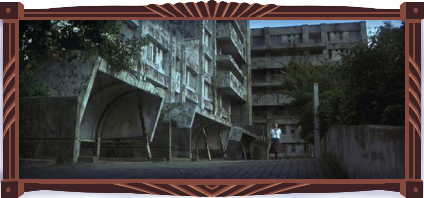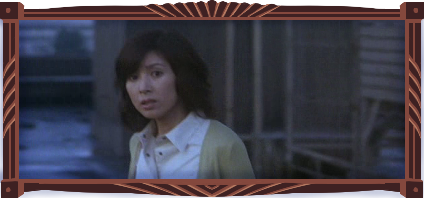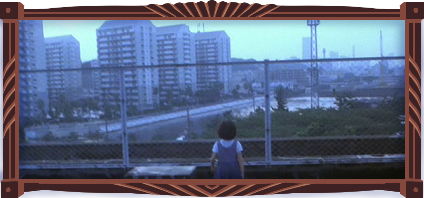From the Depths of Dark Water
The decay of the Japanese home and an elegy to motherhood

★★★☆ Is it fair for a society, cold and slowly rotting through, to demand lofty ideals of warm, perfect homes? Hideo Nakata, director of Ring (1998), makes another comment in From the Depths of Dark Water (2002).
Almost two decades after the J-Horror craze, the trope that Nakata helped establish is well-known, mimicked, and mocked: a young pale ghost child, often a girl with long hair obscuring her face, seeks revenge after dying horribly of child abuse or neglect.
If that were all From the Depths of Dark Water (the English title is simply Dark Water) was, a gory story of a child’s ghost turned cruel after dying equally cruelly, there’d be no point in revisiting the film, except maybe as cheap Halloween fare. Ju-On (2002) from the same year is hardly worth looking at except for a few memorable jump-scares and neat tricks, and that film spawned an entire franchise with thirteen feature-length films, including a second American remake released this year.
From the Depths of Dark Water, though almost unknown compared to Nakata’s earlier Ring, brings the themes of crumbling motherhood in Japan’s Lost Decade into starker relief. Compared to its thematic predecessor, Dark Water is less concerned with sea demons, looming curses, psychic abilities, and supernatural disasters. Here, Nakata has fixed a more intimate focus on a single mother’s struggle to retain her sanity as she settles her daughter in a rundown apartment complex, and fights her ex-husband over child custody.
The film opens with a long underwater shot of sickly, tainted yellow water that evokes bloodless blood, with bright sunlight straining through—or is it invading?—the murky liquid full of floating thick strands. Yoshimi Matsubara (Hitomi Kuroki), an unemployed mother forced to find a new home for her and her child, recalls her own childhood neglect as she waits her turn in family court mediation. Her ex-husband Kunio Hamada (Fumiyo Kohinata) saunters into the sterile lobby. It’s immediately clear the man is a sleazebag biding his time.
Matsubara doesn’t leave the best impression, either. She’s anxious, nervous, high-strung, and desperate to keep her child. Against her ex-husband’s implied slanders against her mental stability and ability to care for their six-year-old daughter Ikuko (Rio Kan’no), she nearly buckles.
Throughout the film, the people around her, the viewer, and she herself doubt her sanity (emotional stability was already out of the question for this woman), as rational explanations for “supernatural”—largely just unpleasant—occurrences arise and even suggest the possibility of conscious sabotage by her ex-husband. Is she losing it? Well, look at the way she screams at red purses… She’s probably already lost it.

Matsubara, like most mothers in Japan, left the workforce after having a child. Six years and a dumpster fire of a marriage later, she has no home to go to, bleak career prospects in a recession—never mind the six-year gap in her resumé—, and no academic, vocational, or creative aspirations or passions. She has nothing but her motherhood and now faces the real possibility of losing that.
In post-bubble Japan, there’s very little room—or life—for isolated women like her. After living out the ideal, the woman was dumped by the very social system that prescribed those expectations in the first place.
Matsubara, desperate for any address away from her ex-husband, settles for an aging, poorly managed apartment complex. Not a single inch of this concrete monolith, inside or outside, is welcoming or crafted to human scale. The geometric “embellishments” (I can hear Tolly gagging) of the brown façade are alien and almost Lovecraftian; barren tall hallways with red fire exit lights are more fit for a warehouse for hardware storage; the bike shelters outside are rusting over and the roofs are stained black by dirty water. Outside the building are a few concrete planters with some bushes and trees, a lazy, obligatory nod to the fact that yes, there is life here, and this is a space intended for human habitation. Dismal doesn’t begin to describe it.
In contrast to Ring’s cross-country road- and boat-trips, Dark Water keeps its settings tightly focused on one Tokyo neighborhood: a kindergarten, an apartment complex, the riverside concrete walkway between the two, and the local family court. The familiar, contemporary settings lend themselves to the uncanny and oppressive air imposed by Dark Water’s gloomy, blue, waterlike sunlight and seemingly relentless rains; Matsubara’s little bubble in Tokyo feels more like the planet Venus in Ray Bradbury’s “All Summer in a Day” than Japan during rainy season. When the rain lets up are few moments of optimism in the film’s diegesis.
Then half a breath after these brief respites, the water mounts another invasion.
The liminal nature of water—which reveals like glass and obscures when filled, a barrier that is permeable, a substance that can seep through cracks and into solid matter itself, and a medium in which matter can be suspended, for better or for worse, is heavily used by the film. Water gives life—it’s essential to cooking, drinking, and bathing. But in a large enough body you can drown in it. The river by the path to Ikuko’s kindergarten looks like an ocean just barely being held back by a pathetic concrete levee—that monstrous body just chooses not to wash away like ants the insignificant humans on the other side.
This continues to be the ideal, though financially restrictive, “career path” for women in Japan today: discrimination against mothers makes almost hopeless prospects for decent full-time jobs, so 60 percent of Japanese mothers in 2016 quit working after their first child.
The last family to view the apartment before Matsubara decides to move in is a family of four, a couple with two young children. From the mother’s accent, it sounds like the family’s just newly moved into the city, and it’s clear they aren’t raking in barrels of cash. The realtor, Mr. Outa (Yuu Tokui) comments that for one adult and one small child, the little two-bedroom apartment offers a lot of space!
Outa preys on Matsubara’s desperation as he pitches her a leaky room. “The early bird gets the worm…”
A comment has to be made on the type of apartment complex—danchi—that Matsubara and Ikuko move into. These concrete-panelled, Khrushchyovka-esque buildings were the Japanese government’s response to a postwar housing crisis: the world’s new second largest economy was left with only 56% of its urban housing intact after the devastation of the Second World War. Hailed as modern housing for a new society and situated in booming, rapidly rebuilding metropolitan hubs, the danchi gave Japan the residential base necessary for the nuclear family unit so vital to the modern capitalist economy. If Americans had dreams of suburban split-level houses paled in by white picket fences and a doghouse, Japanese dreamt of modern city life in apartments that offered individual bedrooms (co-sleeping with dad and grandma isn’t that appealing to a newlywed couple, or anyone who likes to masturbate).
This new housing was in such high demand that some of the lotteries to get into these units were giving odds of 1 to 25,000. In less than a generation, the old ideal of the multigenerational household gave way to the self-contained nuclear family.
Now these buildings are where grandpa’ corpse lie undiscovered on the kitchen floor for three years and where the Filipino migrant workers live. Your embarrassing alcoholic uncle lives there and he curses the lack of elevators every time he has to limp up three flights of concrete stairs (a lot of these apartments were built before accessibility standards—in that respect Matsubara’s apartment is a step up because it has an elevator). Poor people live there. You live there because you’re poor and you don’t want to tell anyone about it. The only neighbors Matsubara sees are two elderly woman and their pet dachshund, and technically the half-senile apartment manager Kamiya (Isao Yatsu), who also lives in the complex.

The rooftop of the apartment complex boasts a scenic view of other danchi, a shipping yard, and a freeway.
That a single, poorly paid mother can afford an apartment in a major city might surprise audiences outside of Japan.
Apartments and homes tend to be cheaper in Tokyo than they are in San Francisco and London (frankly, low bar to set), making it possible for single workers to afford a place on their own without housing assistance. But the lower costs mean less space.
Co-sleeping became unfashionable in these Western-style dwellings, but family bathing never lost its popularity, interestingly enough.
Matsubara’s human surroundings are just as cold to her as the physical ones. The male figures in her life are either incompetent, sleazy, or at best, unsympathetic. The sole exception to this is her divorce attorney, Kishida (Shigemitsu Ogi). As a rational man with a professional and moral duty to safeguard his client’s family from domestic ruin, he’s the stand-in patriarch in Matsubara’s family life. And Kishida does sympathize with the bond between mother and daughter, but he’s less of a white knight and more of a suit being paid to rein in a woman’s hysterics.
As for the women Matsubara interacts with, they have their own affairs to attend to. Despite being a stay-at-home mom for six years, she has no fellow moms to seek support and no friends to give her housewarming gifts. Her parents are non-entities in the film (her mother abandoned her as a young child and it’s not clear if her father is even alive), so she and her daughter lack the extended social safety net that her counterpart in Ring had. She does have an aunt (Chisako Hara)—her mother’s sister—who warmly cares for Ikuko at the apartment when the girl falls ill. But genuine human contact from anyone is fleeting, as Matsubara’s often forced to work overtime in an understaffed publishing house.
Matsubara, the cultural product of an unprecedented economic expansion that has long since ended, is at the end of her rope. From a distance, she watches longingly at happy families in traditional Japanese attire enjoying their summer nights outdoors with Roman candles. Dreams just as fleeting and illusory as the glittering fireworks, dreamt by an anachronism watching another anachronism. Matsubara, ironically, mirrors the ghost of the little girl (Mirei Oguchi) who wants nothing but the same domestic idyll.
In the end, the architecture itself, and by implication the society that built it, is revealed to be responsible for the tragic death of the girl whose spectre haunts Matsubara and her daughter. Outside the “home” and “school”, there’s no place for a Japanese family. Just work, and if you’re feeling adventurous, playing in traffic.
From the Depths of Dark Water, despite holding up the ideal of the self-sacrificing Japanese mother wholly defined by (and I’d argue consumed by) motherhood like its predecessor Ring, is an indictment of the culture that created it. The film is as much a dirge to the archetype of the mother as it is an ode.
That might seem quaint to Western eyes. The stereotype that “women belong in the home” was already considered cringingly sexist and the signature dogma of hardline religious reactionaries by the 1990s in the US, and vexingly backwards to older Japanese leftwing activists, who spent much of their political life fighting for women’s equality in the workforce. But Matsubara is neither a martyr nor a mascot. She, like many parents today, is simply trying her best to keep her head above water.
Additonal comments on the film:
The sound design of the film is outstanding. Kenji Kawai, who returns after scoring Ring, helps build the film’s otherworldly, isolating aura with a concert of echoing bells, screeching strings, and synths. The concrete walls and ceilings of the apartment halls seem to hum with the low, heavy droning of the score, painting the normally soothing sound of rainfall with dread. The score swells along with the film’s emotional and physical climax, and this catharsis concludes with the modest, uncomplicated, pure desire for human closeness.
Nakata uses color well. Yellow, here the color of anxiety, links both the missing Mitsuko and Matsubara: Mitsuko’s raincoat and Matsubara’s cardigan. Ikuko is always on her mother’s mind. Blue tape dispensers in the office recall the kindergartener’s blue school uniform and blue boots. When Matsubara finally sees a bright horizon, she begins to wear sky blue, too. When she goes nuts and publicly tries to wrestle her ex-husband she wears a white long-sleeved jacket—I can’t help but think of a straitjacket here.
The cinematographer, Jun’ichiro Hayashi, is another veteran of Ring. The composition shrinks the two leads in their surroundings, and even when in the company of others, Matsubara and Ikuko are almost always outsiders in relation to the people they’re with, either spatially alienated, or situated outside the other party’s direct line of action or gaze. The eerie cyan tint to what should otherwise be black, shadowy areas is a technique he carried over from Ring.
One composition is especially affecting: when Kishida sits down with Matsubara at her dinner table while Ikuko, centered in the background, plays with building blocks. Bright clear sunlight shines into the room, and the two adults both have glasses of tea. He cheerily encourages Matsubara to do her best.
“Hey, you’re just about there. Ikuko-chan, ready to go back to school?”
“I’m ready!”
“You’re all better now, huh!”
This is as close to a father, and as close to a family life that Matsubara and Ikuko will ever get.
From the Depths of Dark Water is now available on Blu-ray (2016), with new interviews featuring director Hideo Nakata, cinematographer Jun’ichiro Hayashi, and author of the original short story Kouji Suzuki. Buy it directly from UK-based Arrow Films or order it off Amazon.
Alternatively, you can stream the film on Amazon, Google Play, iTunes, Kanopy, Microsoft, Shudder, or YouTube.
Tubi is offering the film for free streaming with advertisements.